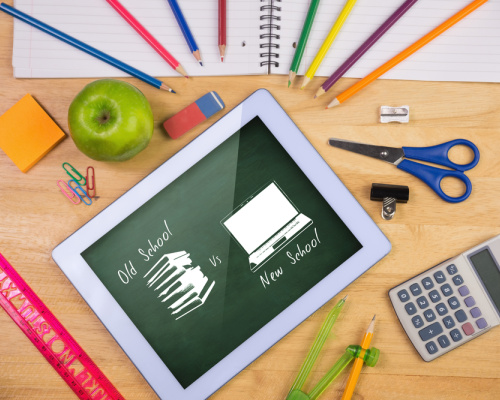Educators and Instructional Tech: Igniting Interest and Sustaining Use
Date
Successfully embedding new technologies within classroom practices requires teachers discovering their “why” and finding a network of ongoing support.
It was 2007, the week before school started. My school’s IT staff wheeled two carts loaded with new laptops into our faculty meeting. A friendly competition ensued as my teaching colleagues and I jockeyed excitedly for blocks on the sign-up sheet.
Fast forward to six months later, early 2008: the carts lay abandoned in hallways maybe 92% of the time. Meanwhile, in our classrooms, my colleagues and I practiced our familiar instructional routines. We weren’t lacking in enthusiasm for the laptops and their array of instructional software, but perhaps missing a sense of intentionality. We hadn’t yet figured out why we needed to integrate these “solutions” within our proven successful, everyday classroom practices. We felt confident we were already providing suitable, effective instruction. None of us were looking for more complexity in our lessons or for the additional classroom management challenges that laptops would undoubtedly have introduced.
After all, counting cubes don’t glitch, quad paper doesn’t require logins, and a pencil never needs charging—why take a different approach just for the sake of using shiny new equipment?
Fast forward from 2008 to today, and any current or former teacher can tell you many similar “left behind edtech” stories that span through the decades. The verbiage around educational technology’s promises may have shifted; the software may have moved to smaller devices; the content may live “in the cloud;” and the connectivity and data integrations may seem more seamless. No matter what may be shiny or trending today, it remains true that when their school or district pushes new edtech, many educators experience a similar arc of enthusiasm into reluctance into passive resistance. Solutions may still sit unused even if they can be amazing for teaching and learning. How can we help educators perceive new edtech for its opportunities rather than for potential obstacles?
Create Possibility Through Empathy
Coming from teaching backgrounds, my colleagues and I answer issues of reluctance and resistance by bringing empathy to our work. We also embrace this fundamental idea:
For classroom technologies to become an essential part of an educator’s practice, a solution must empower the educator to realize or achieve an instructional process they previously found too difficult or just impossible to accomplish.
For educators to change their practices, they must be able to see how the tools provide a pathway to learning, not a barrier. That’s why, when we approach a new project, we spend significant time on user experience research and focused inquiry during the discovery, definition, and design phases of every engagement. We integrate data from a range of qualitative analyses—user empathy maps, interviews, ethnographic research, surveys, and observation—so we can describe and act from a deep understanding of a potential solution’s real-life educator and learner user journeys. We include questions like:
- What are these educators trying to accomplish?
- What’s standing in their way?
- What’s influencing their use of technology for teaching and learning today?
- What pain points are they facing?
- How are they feeling about _______ (e.g., using a particular tool)?
- What really matters to them?
Our goal is to understand what educators need to make them successful. Success isn’t just defined by teachers using the technology, but also by their understanding that using it effectively can empower them to improve student learning outcomes.
Focus on Confidence and Connections, Not Features
As a former educator, I recognize that it’s not enough to engineer and point to handy features with a few fancy samples and how-to tips. Flashy pointers (or shiny devices) don’t often model the digital pedagogy necessary to support a technology’s effective use. And that’s where we come into the picture.
Having been there myself, I know firsthand what works and what doesn’t. I collaborate with educators and iterate on possible formats and protocols that can better align a particular technology to fit their classroom practice so it authentically fits their needs. They might even begin to change their ideas about what’s possible!
To achieve sustained engagement requires educators experiencing for themselves how a solution can multiply their effectiveness. So in the agenda, assets, and facilitation of professional learning workshops or courses we create, we frame the use of a new technology in the context of existing instructional practices. We always feature new tools, services, and materials in a way that models an instructional protocol educators can easily implement with their students, themselves.
For new technologies to appeal authentically, educators need experiences that help them actively experience and use them in instructional settings.
For a while now, we’ve seen professional learning moving beyond technical step-by-step tutorials and into confidence-developing learning experiences built on interactions and shared learning among peers. We believe the most effective professional learning experiences weave in pedagogy and use educators’ real-world contexts for exploration.
To create the conditions for educators to develop supportive networks for these collaborative conversations, we try to structure a range of facilitated and moderated online synchronous and asynchronous co-learning formats that can bring professional peers together. These might take place in-person or virtually, as structured learning activities or informal Twitter threads, and/or at point-of-use inside an app or via a prompt during times of reflection. Just like the students they teach, educators develop their knowledge, abilities, and confidence more readily if they have ongoing opportunities to collaborate, share ideas, ask questions, and see value through discourse with their peers.
The ever changing horizon of instructional technology can be a daunting barrier to truly transformative instruction. At Clarity, we take a whole-solution approach to ensuring that we are not only developing innovative technologies, but we are also designing solutions that support and enable educators to adopt technology as an invaluable tool to enhance their existing teaching practices.

